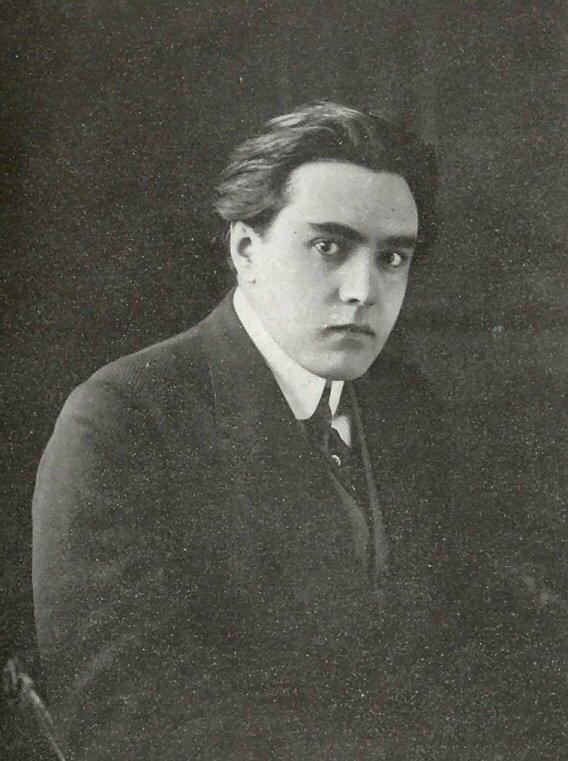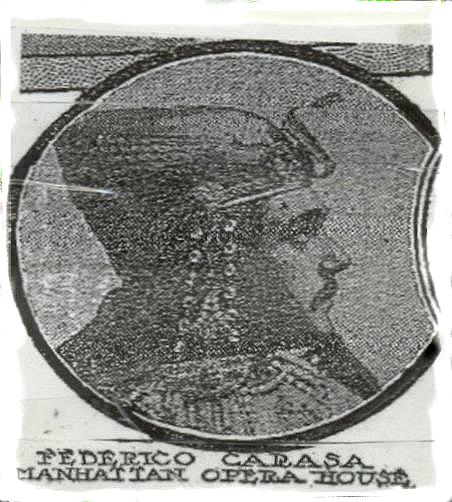Spanish tenor Federico Carasa was born in Donostía-San Sebastián (Spain) on June 6th, 1887. His complete
name was Melchor Federico Carasa Torre and he was the son of Evaristo Carasa Yñiguez and Saturnina Torre
Romero.
In the edition of December 14th, 1902, the newspaper "El Globo" announced that Federico Carasa had won the prize in a
contest organized by another periodical, "Blanco y Negro". The readers had to send their opinion about the best politician,
novelist, poet, musician, etc. in Spain. The winner was a young man working as an accountant in San Sebastián.
His name was Federico Carasa, and the prize was a beautiful gold watch.
Carasa wanted to study and become a lawyer but, at the same time, entered the Orfeón Donostierra (a famous Basque folk music choir) directed by Don
Secundino Esnaola. Very soon he became the tenor soloist of the Orfeón.
Politically, Carasa was a Republican, as we deduce from a press information (El Pais, 4 February 1905), informing that
Carasa was appointed Vice Secretary of the Republican Youth.
In May of 1905, the French branch of the Gramophone Company visited San Sebastián to record Basque music. Federico
Carasa as a soloist of the Orfeón Donostierra was engaged to sing and record six Basque songs that were issued in
August 1905.
During the Summer of 1906, the former baritone Marquis of Trabadelo was enjoying his holidays in San Sebastián. He
attended a concert by the Orfeón Donostiarra and was astonished with the voice of the soloist singer, with a pure,
warm and lovely tenor voice. He called him and asked him about his future aspirations. The young man confessed that he
wanted to become a lawyer. Trabadelo told him that he thought that was "a crime" and that he should not lose the gift of
his God-sent voice. He convinced him to go to Paris where he would teach him vocal technique and prepare him for a singing
career.
Carasa went to Paris and studied with Trabadelo for two years. The teacher thought his pupil was ready to face the public.
The tenor appeared on 14 August 1908 at the Teatro Circo in San Sebastián in a concert organized by the
Orfeón Donostiarra to honour him and Trabadelo. Both artists sang in that concert.
The stage debut of Carasa took place the same year in Gent, where he sang Aida, Il trovatore and Les huguenots. He achieved
a total success, and Trabadelo wrote to the Covent Garden management in London. Carasa was accepted and made his debut in
England as Turiddu in Cavalleria rusticana, in April 1909 (three performances). The cast included the soprano Tina de Sana,
the baritone Angelo Scandiani, the mezzosopranos Jane Bourgeois and Miss Moresta, and conductor Cleofonte Campanini. He was
so enthusiastically received that he was even compared with Caruso while others said He is a new Tamagno. Covent
Garden then offered him a three-year contract with a minimum of 20 performances, but the tenor took the advice of his
teacher and preferred to accept the offer made by Oscar Hammerstein, from the Manhattan Opera House in New York, of an
eight-season contract with the only condition that, during that time, he would not be allowed to sing in Europe.

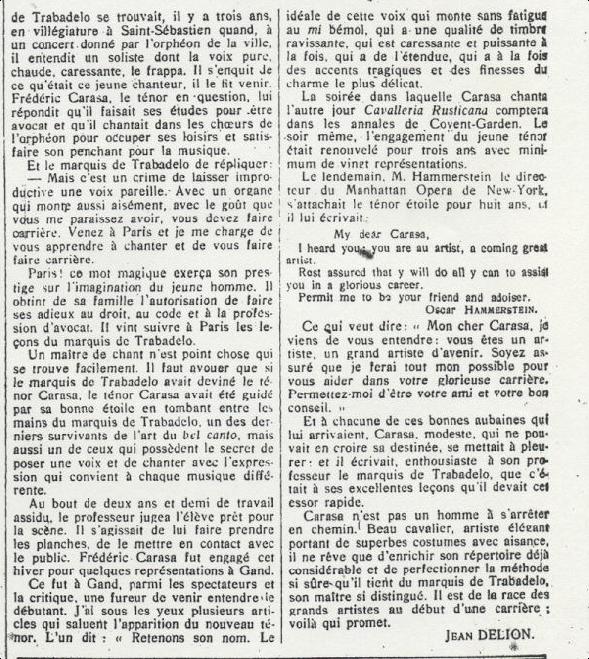 Comoedia, 8 May 1909
Comoedia, 8 May 1909
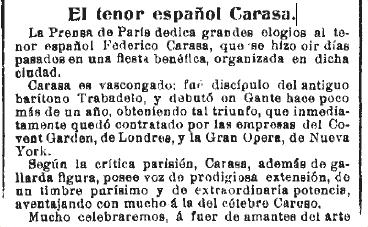
 La Época, 12 June 1909
La Época, 12 June 1909
However, he was authorized to sing in some benefit concerts. One of them was in Paris, in June 1909, for the Retired
Dramatic Artists Home. Carasa sang Tosti's "La mia canzone", "La donna è mobile" from Rigoletto, an aria from Il
trovatore and some other numbers to correspond to the enthusiastic audience demand. It was said High and manly, he moves easily and confident on stage, with a prodigious voice (reaching E flat) and with a pure
voice, easily produced and of astonishing agility. (...) He is a worthy rival of Caruso. (El Imparcial, 12 June 1909)
On August 9th, 1909, he sang in another concert, this time at the Teatro Circo in San Sebastián, for the benefit of
the families of the soldiers wounded in Melilla. In this concert, also the soprano Enriqueta Acevedo and the baritone
Isasti sang, being accompanied by pianist Cagliostro. On August 11th, Carasa and his pianist left for Paris and then for Le
Havre to ship for New York. The press said that Carasa will outshine Caruso.
... and then he (Hammerstein) went into raptures about his new Spanish tenor, señor Federico de Carasa, the equal
of Caruso, he said. Señor de Carasa is 22 years old. He carries an eight-year contract as the result of his
interviews with Mr. Hammerstein. That was the longest contract, it was said, that any singer has succeeded into making.
(New York Tribune, 30 June 1909)
Carasa's debut in New York took place on 31 August 1909:
The much heralded Spanish tenor, Federico Carasa made his American debut at the Manhattan Opera House Tuesday evening,
August 31st, appearing as Radamès in Verdi's Aida. He faced a large and critical audience whose friendly applause was
tinged with evident disappointment. Carasa did not justify the expectations of his auditors or the many claims made for him
as a supreme artist. He certainly was the finest looking Radamès ever seen in New York, and he assuredly has great natural
endowments, both vocal and dramatic, but they do not seem to be fully matured or under his complete control. He made a
strong impression, however, and after the third act received nine curtain calls. (New York Dramatic Mirror, 11
September 1909)
 The New York Times, 12 September 1909
The New York Times, 12 September 1909
The following is the summary of all the operas the Spanish tenor sang with the Manhattan Opera Company:
Season 1909/10
Manhattan Opera, New York
Aida: Alice Baron, Berthe Soyer, Enrico Pignataro, Henri Scott; Giuseppe Sturani (31 August, total 3)
Rigoletto: Lalla Miranda, Alice Gentle, William Beck, Scott; Sturani (10 September, total 3)
Pagliacci: Marguerite Sylva, Henry Laskin, Nicolò Fossetta; Sturani (17 September, total 2)
Tosca: Eva Grippon/Sylva/Baron, Beck; Sturani (18 September, total 3)
Carmen: Sylva, Mme. Walter-Villa, Laskin; Carlo Nicosia (9 October)
Cavalleria rusticana: Sylva, Gentle, Pignataro; Sturani (18 October)
Philadelphia Opera House
Carmen: Sylva, Walter-Villa, Laskin; Nicosia (13November)
Cavalleria rusticana: Mariette Mazarin, Giovanni Polese: Sturani (20 November)
Pagliacci: Emma Trentini, Fossetta: Sturani (4 December)
Tosca: Carmen Melis, Polese: Sturani (11 December)
Nixon Theatre, Pittsburgh
Tosca: Melis, Maurice Renaud; Oscar Anselmi (21 December)
Manhattan Opera, New York
Carmen: Lina Cavalieri, Regina Vicarino, Laskin: Henriquez de la Fuente (24 December)
Tosca: Melis, Mario Sammarco; de la Fuente (25 December)
Philadelphia Opera House
Lucia di Lammermoor: Luisa Tetrazzini, Polese, Scott: Sturani (22 January)
NOTE: The performance of 22 January 1910 was the last one sung by Carasa for the Manhattan Opera Company. Of the promised
eight seasons, he sang only one.
Something happened after January 1910; probably a serious illness that prevented him from fulfilling his international
contracts. The Spanish newspaper "El Heraldo de Madrid" reproduced in its edition of 28 May 1910 the telegrams sent from
Odessa (Russia) to Trabadelo, requesting him to force the tenor to urgently go to Russia, where he was engaged to sing Les
huguenots:
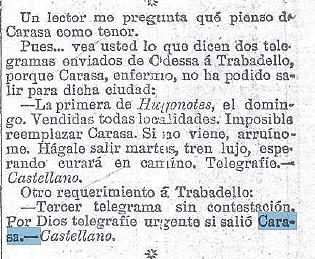
The first performance of Huguenots is on Sunday. The house is sold out, impossible to replace him. If he does not come,
it will mean bankrupt. Make him to part on Tuesday, in luxury train, hoping he will recover in transit, and then,
For God's sake, urgently send me a telegram and say if Carasa is coming. Apparently, none of those telegrams was
answered, and Carasa did not sing in Odessa that year.
In 1910, Carasa signed a contract with the impresario Adolfo Bracale; as a member of his company he would sing in Vienna,
Odessa (one year belated), Constantinople and Athens.
In June/July 1910 he sang at the Carltheater in Vienna. His debut was in Il trovatore (28 June), with Giulia
Anderson-Protti, Regina Alvarez, Alessandro Modesti, Giovanni Bardi and Torquato Bonazzi. Then he sang in Carmen
(in July) with Regina Alvarez and Torquato Bonazzi. We do not know if he sang one or several performances. It is
possible that he also sang in La traviata (1 July). The other tenor was Eugenio Folco, who sang in La bohème and
Lucia di Lammermoor.
In February 1911, Carasa sang in Nice:
Nice, Casino Municipal
Tosca (February) with Mme Catalan and Alfred Maguenat
Pagliacci (February)
The reviews were enthusiastic, mainly in Pagliacci:
À Nice, Paillasse, interprète par le célèbre ténor Carasa, dans le rôle de
Canio, a obtenu Mercredi soir, au Casino municipal, un énorme succès. Ce bel artiste s'y montra
comédien supérieur autant que merveilleux chanteur. Ses admirables qualités vocales et dramatiques
enthousiasmèrent au plus haut point la salle tout à fait comble qui le couvrit d'applaudissements et qui,
à diverses reprises, lui fit bisser ses principaux airs et lui témoignèrent, par des rappels sans
nombre, à chaque baisser de rideau, son admiration dans ce rôle auquel il apporte une interprétation
au-dessus de tout éloge. (Le Monde Artiste, 18 February 1911)
In April 1911 he made his belated debut in Odessa (with the Bracale Company):
We receive a telegram notifying us that the tenor Carasa earned many ovations at the theater in Odessa where he is
singing Tosca, Pagliacci, Cavalleria rusticana. During each performance there was a series of encores and numerous curtain
calls that saluted the superb voice of this artist and his magnificent dramatic temperament. M. Carasa had promised to
sing next week Lohengrin and the Huguenots due to his huge success. (Le Monde Artiste, 25 March 1911)
Further Odessa performances in 1911:
7 April Aida, with Ester Adaberto, Regina Alvarez, Ernesto De Marco
?? April Il trovatore, with Maria Viscardi, Alvarez, Oreste Benedetti
16? April Carmen, with Alvarez, De Marco
25? April L'Africaine (possible)
29 April La Juive (possible)
?? May Samson et Dalila, with Alvarez, De Marco
13 May La favorite (possible)
The other tenor in the company was Manfredo Polverosi.
After Russia, the company visited Turkey and Greece.
Constantinople, 1911
20? May Aida, with Adaberto, Alvarez, De Marco
Other possible operas were Tosca, Carmen, Samson et Dalila. Manfredo Polverosi, too, was in Constantinople.
The Bracale Company made performances in Athens, but we don't know if Carasa sang there.
On 26 and 28 August 1911, the tenor sang at the Teatro Circo in San Sebastián, two performances of Pagliacci.
En el teatro-circo cantó "Pagliacci" el tenor dénostiarra Federico Carasa; obtuvo un gran triunfo. (El
Imparcial, 27 August 1911)
On October 1st, 1911, Carasa made his debut at the Gaité-Lyrique in Paris, singing Pagliacci in French, with Jeanne
Guionie (soprano), Dinh Gilly (baritone) and Alfred Maguenat (baritone). During that season there were 11 performances of
Pagliacci, but the role of Canio was shared with Thomas-Salignac.
A côté d'elle (i.e. Guionie) le tenor Carasa se couvre de gloire dans le rôle de Canio auquel il
prêtait le concours de son séduisant organe et son jeu pathétique.
Federico Carasa sang in January and February 1912 at the Great Hall of the conservatory in St. Petersburg:
Tannhäuser (in Italian): Giannina Russ, Mattia Battistini, Vittorio Arimondi (25 January)
Les huguenots: Russ, Olimpia Boronat, Arimondi (29 January)
Un ballo in maschera: Russ, Battistini, Arimondi (10 February)
Sergei Levik in his book "An opera singer's notes" wrote the following on Carasa:
What were their distinguishing features (i.e. Italian singers)? First and foremost powerful
and carrying voices which frequently were over-loud even when of good quality. Carasa could sing roles like Radamès or
Raoul and even Tannhäuser, on two or three days in a row without showing the slightest sign of fatigue.
A mezzo-carattere rather than a dramatic tenor, he would stand out in any ensemble. It was not because of his style,
training or even virtuosity but because of the amazing healthy nature of his voice – and that was it.
Tomars once asked Battistini with whom the tenor Carasa had studied. "That tenor has never done any real work", he
said, and the ghost of a smile passed over his face; from which Tomars, himself a professor of singing, deduced that Carasa
had had no real training.
The spectator (Tannhäuser in Italian) simply surrendered to the Italian Carasa's singing
of Tannhäuser's narration in the third act, which, although rather coarse and lachrymose, had great breath-control and
feeling.
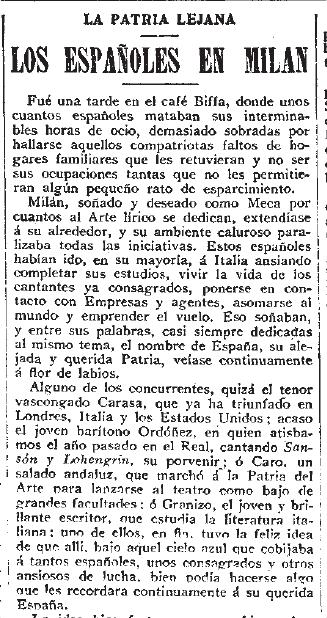
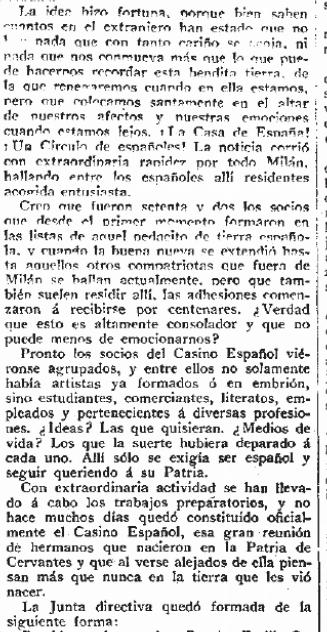
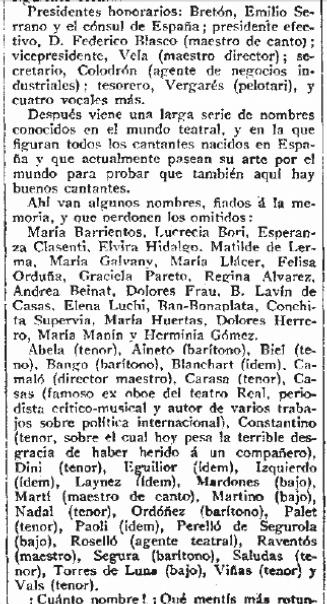
 La Correspondencia de España, 27 August 1912
La Correspondencia de España, 27 August 1912
Federico Carasa sang only one performance at the Teatro Real in Madrid, a performance that seems to have been a total
disaster.
Madrid, Teatro Real, 28 February 1914
La traviata: Luz de Rugama, Giuseppe Bellantoni, Rosalía Pancrazy, Carlos del Pozo, Martín Verdaguer,
Antonio Oliver, Roldán, Fúster; Alfredo Padovani
The critics in Madrid were merciless with the singers making their debuts, a soprano with the only merit of belonging to
the aristocratic Spanish high society and a tenor that had burned the treasure of his voice in less than five career years.
Her (i.e. Luz de Rugama's) voice, with a nice timbre, is small and short; she has a singing method to go and sing at her
home; the embellishments are taken and developed as she wishes, no matter of the result, it's unimportant. One note more or
less, who cares?, some people might say; well, we at the Teatro Real would answer.
As far as her partner in displeasure and trouble, tenor Carasa, there was not the least sign of compassion for him; he was
judged like
an artist that has been singing for five years deserves, and that according to the press, had the courage to pretend to
compete with Caruso in New York. There, he is nobody! (El Duende, 8 March 1914).
The above makes us think that this performance at the Teatro Real in Madrid was the last time Federico Carasa sang on stage
as an opera singer.
It has been said that a laryngitis put an end to his career (Heraldo de Madrid, 1 November 1930), but it may also be that
his artistic talent was not so much as some thought at the start of his career. He returned to his native San
Sebastián, and in 1918 founded an insurance company (Vascongadas Seguros y Reaseguros).
The newspaper "El Sol" of 29 May 1932 informed that the groups in San Sebastián and Irún at the service of
the Republic, agreed to form the Guipuzcoan section of the party, appointed a board of directors, and Don Federico
Carasa was chosen as president. The party to which the article was referring is the Republican
Party; Carasa was now an active local politician, and even became mayor of San Sebastián for a short time in 1936.
In 1938, Federico Carasa wrote and published a book Presos de los rojo-separatistas. Navarros, guipuzcoanos y
vizcaínos (Ávila 1938). "Captured by the red separatists. From
Navarra, the Basque Country and Vizcaya" – the Spanish Republicans between the two World Wars were fiercely left-wing,
but, somewhat incongruously, also fierce Spanish nationalists and hence sworn enemies of all (Basque, Catalan
and so on) autonomy movements.
Discography
Gramophone, San Sebastián, May 1905
8581u Nere senarra (trad.) G62280
8583u Laurak bat (Larregla Urbieta) G62281
8584u Kaiku (trad.) (w. Ignacio Erquicia) G64138
8586u Nere etorrera (Iparraguirre Balerdi) G62283
8588u Agur Euskalerriari (Iparraguirre Balerdi) G62288
8590u Uso xuria errazu (trad.) G62289
This discographical information has been kindly provided by Sr. Jaione Landaberia Taberna, of Eresbil, Basque Music Archive.
Juan Dzazópulos, April 2015
